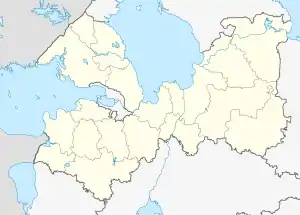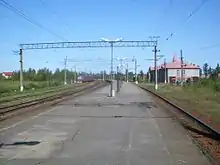Imeni Morozova
имени Морозова | |
|---|---|
Location of Imeni Morozova | |
 Imeni Morozova Location of Imeni Morozova  Imeni Morozova Imeni Morozova (Leningrad Oblast) | |
| Coordinates: 59°58′30″N 31°02′15″E / 59.97500°N 31.03750°E | |
| Country | Russia |
| Federal subject | Leningrad Oblast |
| Administrative district | Vsevolozhsky District[1] |
| Population | |
| • Total | 10,873 |
| • Estimate (2018)[3] | 10,570 (−2.8%) |
| • Municipal district | Vsevolozhsky Municipal District[4] |
| • Urban settlement | Morozovskoye Urban Settlement[4] |
| • Capital of | Morozovskoye Urban Settlement[4] |
| Time zone | UTC+3 (MSK |
| Postal code(s)[6] | 188679 |
| OKTMO ID | 41212563000 |
| Website | www |
Imeni Morozova (Russian: и́мени Моро́зова) is an urban locality (an urban-type settlement) in Vsevolozhsky District of Leningrad Oblast, Russia, located on the bank of Lake Ladoga by the source of the Neva River, northeast of Saint Petersburg. Municipally it is incorporated as Morozovskoye Urban Settlement, one of the eight urban settlements in the district. Population: 10,873 (2010 Census);[2] 10,677 (2002 Census);[7] 12,347 (1989 Census).[8]
History
In the end of the 19th century, the area where the settlement was currently located was occupied by the datcha (a summer estate) by Vladimir Rennenkampf. In 1882, the lands were given on lease to Vladimir Ronchevsky to build the Shlisselburg Gunpowder Plant, which started operation in 1883. Imeni Morozova developed as a settlement serving the plant. At the time, it belonged to Shlisselburgsky Uyezd of Saint Petersburg Governorate. In 1913, the governorate was renamed Petrograd.[9] On February 14, 1923 Shlisselburgsky Uyezd was merged into Petrogradsky Uyezd. In January, 1924 the uyezd and the governorate were renamed Leningradsky.[10]
In 1922, the gunpowder plant was renamed Imeni Morozova Plant, for Nikolay Morozov. The settlement was renamed as well, and it was administratively subordinated to the town of Shlisselburg.
On August 1, 1927, the uyezds were abolished and Leninsky District, with the administrative center in the settlement of Vsevolozhskoye, was established. The governorates were also abolished, and the district was a part of Leningrad Okrug of Leningrad Oblast.[11] On August 19, 1930 Leninsky District was abolished and merged into newly established Leningradsky Prigorodny District with the administrative center in the city of Leningrad. On August 10, 1934 Imeni Morozova was detached from the town of Shlisselburg (which was the town of oblast significance and not a part of the district) and transferred to Leningradsky Prigorodny District. On August 19, 1936 Leningradsky Prigorodny District was abolished, and Vsevolozhsky District, with the administrative center in Vsevolozhskoye, was established. Imeni Morozova became a part of Vsevolozhsky District.[12]
During World War II, Imeni Morozova was not occupied and played a key role in channeling supplies to the city of Leningrad. In particular, a temporary bridge over the Neva was built south of the settlement and was used for the transport of goods.
Economy
Industry
The settlement was created to serve the Shlisselburg Gunpowder Plant, however, the plant went bankrupt in the 1990s. Some parts of the plant are still in operation, producing electrotechnical equipment and plastic goods. There are also food industry enterprises.[9]
Transportation

Imeni Morozova is located on the railway connecting Saint Petersburg with Nevskaya Dubrovka railway station via Vsevolozhsk. The settlement has two railway stations, 21 km and Petrokrepost. There is suburban service to the Finland Station in Saint Petersburg.
Imeny Morozova is connected by roads with Vsevolozhsk and Rakhya, and has access to the M18 highway, which connects Saint Petersburg with Murmansk via Petrozavodsk.
The Neva is navigable.
Culture and recreation
Imeni Morozova contains two cultural heritage monuments of federal significance and additionally five objects classified as cultural and historical heritage of local significance.[13] These are related to the Road of Life, which was connecting Leningrad with the rest of Soviet Union during the Siege of Leningrad in 1941—1944.
References
Notes
- 1 2 Государственный комитет Российской Федерации по статистике. Комитет Российской Федерации по стандартизации, метрологии и сертификации. №ОК 019-95 1 января 1997 г. «Общероссийский классификатор объектов административно-территориального деления. Код 41 212 563 001», в ред. изменения №278/2015 от 1 января 2016 г.. (State Statistics Committee of the Russian Federation. Committee of the Russian Federation on Standardization, Metrology, and Certification. #OK 019-95 January 1, 1997 Russian Classification of Objects of Administrative Division (OKATO). Code 41 212 563 001, as amended by the Amendment #278/2015 of January 1, 2016. ).
- 1 2 Russian Federal State Statistics Service (2011). Всероссийская перепись населения 2010 года. Том 1 [2010 All-Russian Population Census, vol. 1]. Всероссийская перепись населения 2010 года [2010 All-Russia Population Census] (in Russian). Federal State Statistics Service.
- ↑ "26. Численность постоянного населения Российской Федерации по муниципальным образованиям на 1 января 2018 года". Federal State Statistics Service. Retrieved January 23, 2019.
- 1 2 3 Law #17-oz
- ↑ "Об исчислении времени". Официальный интернет-портал правовой информации (in Russian). June 3, 2011. Retrieved January 19, 2019.
- ↑ Почта России. Информационно-вычислительный центр ОАСУ РПО. (Russian Post). Поиск объектов почтовой связи (Postal Objects Search) (in Russian)
- ↑ Russian Federal State Statistics Service (May 21, 2004). Численность населения России, субъектов Российской Федерации в составе федеральных округов, районов, городских поселений, сельских населённых пунктов – районных центров и сельских населённых пунктов с населением 3 тысячи и более человек [Population of Russia, Its Federal Districts, Federal Subjects, Districts, Urban Localities, Rural Localities—Administrative Centers, and Rural Localities with Population of Over 3,000] (XLS). Всероссийская перепись населения 2002 года [All-Russia Population Census of 2002] (in Russian).
- ↑ Всесоюзная перепись населения 1989 г. Численность наличного населения союзных и автономных республик, автономных областей и округов, краёв, областей, районов, городских поселений и сёл-райцентров [All Union Population Census of 1989: Present Population of Union and Autonomous Republics, Autonomous Oblasts and Okrugs, Krais, Oblasts, Districts, Urban Settlements, and Villages Serving as District Administrative Centers]. Всесоюзная перепись населения 1989 года [All-Union Population Census of 1989] (in Russian). Институт демографии Национального исследовательского университета: Высшая школа экономики [Institute of Demography at the National Research University: Higher School of Economics]. 1989 – via Demoscope Weekly.
- 1 2 История посёлка им. Морозова (in Russian). Морозовское городское поселение. Archived from the original on April 10, 2013. Retrieved April 25, 2013.
- ↑ Петроградский уезд (1917 - янв. 1924), Ленинградский уезд( янв.1924 г.- авг. 1927 г.) (in Russian). Система классификаторов исполнительных органов государственной власти Санкт-Петербурга. Archived from the original on December 28, 2013. Retrieved April 26, 2013.
- ↑ Ленинский район Ленинградского округа (август 1927 г . - август 1930 г .) (in Russian). Система классификаторов исполнительных органов государственной власти Санкт-Петербурга. Archived from the original on March 20, 2014. Retrieved April 12, 2013.
- ↑ Всеволожский район (август 1936 г .) (in Russian). Система классификаторов исполнительных органов государственной власти Санкт-Петербурга. Archived from the original on March 18, 2014. Retrieved April 12, 2013.
- ↑ Памятники истории и культуры народов Российской Федерации (in Russian). Russian Ministry of Culture. Retrieved June 2, 2016.
Sources
- Законодательное собрание Ленинградской области. Областной закон №32-оз от 15 июня 2010 г. «Об административно-территориальном устройстве Ленинградской области и порядке его изменения», в ред. Областного закона №23-оз от 8 мая 2014 г. «Об объединении муниципальных образований "Приморское городское поселение" Выборгского района Ленинградской области и "Глебычевское сельское поселение" Выборгского района Ленинградской области и о внесении изменений в отдельные Областные законы». Вступил в силу со дня официального опубликования. Опубликован: "Вести", №112, 23 июня 2010 г. (Legislative Assembly of Leningrad Oblast. Oblast Law #32-oz of June 15, 2010 On the Administrative-Territorial Structure of Leningrad Oblast and on the Procedures for Its Change, as amended by the Oblast Law #23-oz of May 8, 2014 On Merging the Municipal Formations of "Primorskoye Urban Settlement" in Vyborgsky District of Leningrad Oblast and "Glebychevskoye Rural Settlement" in Vyborgsky District of Leningrad Oblast and on Amending Various Oblast Laws. Effective as of the day of the official publication.).
- Законодательное собрание Ленинградской области. Областной закон №32-оз от 15 июня 2010 г. «Об административно-территориальном устройстве Ленинградской области и порядке его изменения», в ред. Областного закона №23-оз от 8 мая 2014 г. «Об объединении муниципальных образований "Приморское городское поселение" Выборгского района Ленинградской области и "Глебычевское сельское поселение" Выборгского района Ленинградской области и о внесении изменений в отдельные Областные законы». Вступил в силу со дня официального опубликования. Опубликован: "Вести", №112, 23 июня 2010 г. (Legislative Assembly of Leningrad Oblast. Oblast Law #32-oz of June 15, 2010 On the Administrative-Territorial Structure of Leningrad Oblast and on the Procedures for Its Change, as amended by the Oblast Law #23-oz of May 8, 2014 On Merging the Municipal Formations of "Primorskoye Urban Settlement" in Vyborgsky District of Leningrad Oblast and "Glebychevskoye Rural Settlement" in Vyborgsky District of Leningrad Oblast and on Amending Various Oblast Laws. Effective as of the day of the official publication.).
- Законодательное собрание Ленинградской области. Областной закон №17-оз от 10 марта 2004 г. «Об установлении границ и наделении соответствующим статусом муниципальных образований Всеволожский район и Выборгский район и муниципальных образований в их составе», в ред. Областного закона №23-оз от 8 мая 2014 г. «Об объединении муниципальных образований "Приморское городское поселение" Выборгского района Ленинградской области и "Глебычевское сельское поселение" Выборгского района Ленинградской области и о внесении изменений в отдельные Областные законы». Вступил в силу со дня официального опубликования. Опубликован: "Вести", №27, 11 марта 2004 г. (Legislative Assembly of Leningrad Oblast. Oblast Law #17-oz of March 10, 2004 On Establishing the Borders of and Granting an Appropriate Status to the Municipal Formations of Vsevolozhsky District and Vyborgsky District and to the Municipal Formations Comprising It, as amended by the Oblast Law #23-oz of May 8, 2014 On Merging the Municipal Formations of "Primorskoye Urban Settlement" in Vyborgsky District of Leningrad Oblast and "Glebychevskoye Rural Settlement" in Vyborgsky District of Leningrad Oblast and on Amending Various Oblast Laws. Effective as of the day of the official publication.).